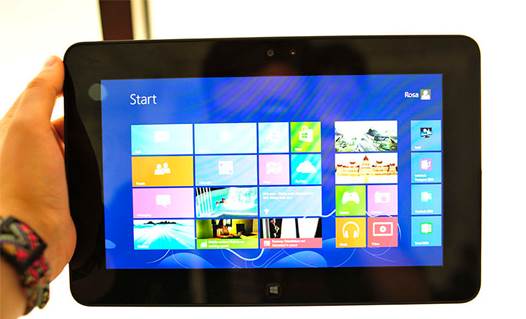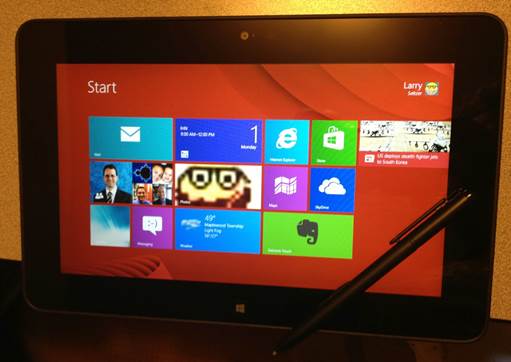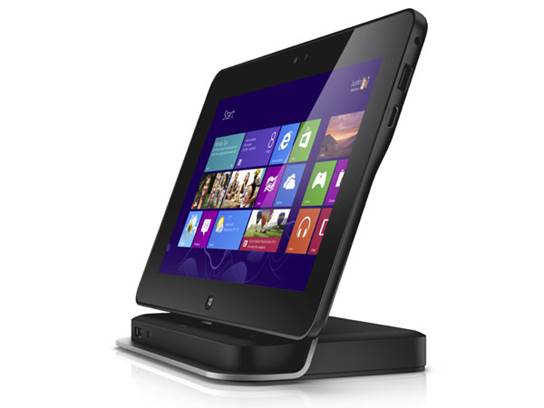We have made an imposing tour on the Windows
8 hybrid computer running the low-capacity Atom processors, and our latest stop
is Latitude 10 of Dell. While the same systems, such as Asus VivoTab Smart and
Lenovo ThinkPad Tablet 2, concentrate on the portable design and long battery
life, Latitude 10 is similar to that device group with “Smart” and “Pro” in
their name.
Indeed, like Surface Pro and Samsung ATIV
Smart PC Pro, Latitude 10 shows off a lot of business-friendly features, such
as TPM, power-increasing dock, a stylus gaining Wacom certificate and Bluetooth
keyboard. The basic configuration will make you spend 499 USD, but adding the
essential things for the job such as dock and keyboard may soon make you pass
the 1.000USD threshold. Does Latitude 10 work well enough to bang for the bucks
– and satisfy the on-the-road experts? You know where to look for that if you
want.

Indeed,
like Surface Pro and Samsung ATIV Smart PC Pro, Latitude 10 shows off a lot of
business-friendly features
Design and feelings
“Innocuous” is the word we use to describe
the design of Latitude 10 and we figure that’s what many business customers
will want. Though we don’t have the misgivings with the straightforward
black-rectangle-shaped aesthetic, we have problems with the extremely large
bezel surrounding the 1,366x768 screen. This makes the device look cheap and
makes the 10.1inch screen seems to be smaller.

“Innocuous”
is the word we use to describe the design of Latitude 10
With 1.45 pound and 0.4inch thick with 30Whbattery,
it’s not even with the currently thinnest 10.1-inch laptop, but it feels solid
in hands. This is thanks to the magnesium-alloy frame reinforcing it, and the Gorilla
Glass layer doesn’t cause any damage. The back has soft surface which creates a
comfortable grip – you shouldn’t put the solid design of this tablet onto a
test with any accidental drop.
In general, the button and port positions
are completely logical on Latitude 10 and there’s no lack of interior
connections. The physical Windows 8 Start button sits on the typical position
under the screen. However, how strange it is when this button is a little
indented instead of bulged, and as a result it’s pretty hard to press. We have
to use more force than we get used to, and especially it have trouble realizing
1 press when the tablet is set upright in the built-in dock. The only feature
you will realize at the front is the 2MP front camera.

In
general, the button and port positions are completely logical on Latitude 10
The top edge of Latitude 10 is the place of
the large-sized SD slot, power button and the auto-rotating switch. Model
Enhanced Security, which we have a change to test, includes a smart card reader
along the top. The headphone/mic combined jack, USB 2.0 port and mini-HDMI
connection sit on the left edge, while you will find the volume rocker and the Kensington
lock sot sitting on the left. Finally, the power connector and a micro-USB port
sit on the bottom. Turn the device upside down, and you will see that many
things are happening. Besides the 8MP camera with LED flash, Dell logo and 2
small sets of speakers, convertible 30Wh battery sit outstandingly on the back,
with a slide lock allowing removing. (The larger 60Wh battery is included with
our testing unit – we will tell you more later).
Our model provides 3G connection, and the micro-SIM
slot sitting under the battery is removable. The battery occupies half of the
surface, and while this breaks the narrow lines, our promise of long battery
life exceeds any superficial concern. We have to loosen 2 2-cell and 4-cell
batteries when changing battery because the latch system is stuck on its half
travel when we try to move it.
ETC.
Many configuration options for Latitude 10 are
almost confusing. There’s not only Essential, Standard and Enhanced Security model
but also many optional accessories. We have tested the already-paced Latitude
10 with productivity-increasing dock, a 100USD accessory. This 1.8pound
accessory adds a huge number of ports which are already impressive, 4 USB 2.0
connections, headphone jack and a large-sized HDMI to connect to the external
screen. There’s also a power connector to charge the tablet when it’s docked.

Many
configuration options for Latitude 10 are almost confusing.
It’s easy to attach the Latitude 10 to the
support, but it fells shaky; lifting the tablet up will remove it from the
support and you don’t even need to use much power to do so. We imagine that dock
will not move too far from users’ desk, and it provides comfortable viewing
angle – though not adjustable to watch the films as well as compose emails and
docs. Other accessories include the composed Bluetooth keyboard and a mouse (from
40 to 86 USD, depending on which packs you choose among the 3 optional packs) and
a 40USD soft cover which can play the role as a support. Our testing unit also
includes the 40USD Dell KM632 keyboard and mouse pack, along with the cover.
Talking about the Bluetooth keyboard and
mouse, we have to force ourselves using the device in tablet mode after
enjoying this setting. Of course you will want a hardware keyboard if you
intend to do any practical jobs, and the Chiclet keys as well as the mouse are
fast and comfortable for navigating Windows 8. Specifically, the Bluetooth keyboard
has the size of the desktop computer, which means that the 10.1inch screen
fells small in comparison. Another complaint: the top of the mouse is removable
allowing you to insert 2 AA batteries, but it plucks out too easily. We have to
fit it several times during the test. Dell doesn’t provide the separate
keyboard cover, instead of that, it sells Kensington KeyFolio Expert through
website.